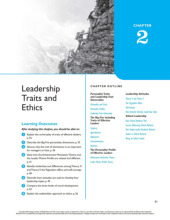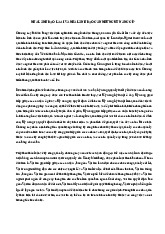




Preview text:
LEADERSHIP
1. John Kotter's view argues that management focuses on coping with
complexity, whereas leadership focuses on coping with _____. a. conflict b. success c. defeat d. morale e. change
2. Which of the following roles focuses on bringing about order and
consistency by drawing up formal plans? a. leadership b. management
c. task structure
d. initiating structure
e. none of the above
3. Leadership is best defined as _____.
a. the ability to influence a group in goal achievement
b. keeping order and consistency in the midst of change
c. implementing the vision and strategy provided by management
d. coordinating and staffing the organization and handling day-to-day problems
e. not a relevant variable in modern organizations
4. Which of the following statements regarding leadership is true? a. All leaders are managers.
b. Formal rights enable managers to lead effectively. c. All managers are leaders.
d. All leaders are hierarchically superior to followers.
e. Nonsanctioned leadership is as important as or more important than
formal influence.
5. Which theory differentiates leaders from nonleaders by focusing on
personal qualities and characteristics? a. Fiedler's perspective
b. characteristic theory c. LPC
d. contingency theory e. trait theory
6. According to a comprehensive review of the leadership literature, what
is the most important trait of effective leaders? a. conscientiousness b. openness c. extraversion d. agreeableness e. emotional stability
7. Recent studies indicate that ________ may indicate effective leadership.
a. an endless supply of terrific ideas b. a compelling vision c. a highly analytical mind d. outstanding training
e. emotional intelligence
8. Emotional intelligence is so critical to effective leadership because one
of its core components is ________. a. conscientiousness b. empathy c. openness d. extraversion
e. agreeableness
9. There is fairly strong evidence that traits can predict _____ more
accurately than leadership effectiveness. a. leadership emergence b. extraversion in leaders c. leadership awareness d. leadership competence
e. the conscientiousness of leaders
10. Trait research suggests that we focus on _____, whereas behavioral
studies imply that we can effectively _____.
a. teaching people certain traits; teach people certain behaviors
b. selecting the right person for a job; train leaders
c. changing jobs to suit people; change people to suit jobs
d. training new employees; dispense with training
e. identifying certain traits in leaders; ignore leaders' traits
11.If trait theories of leadership are valid, then leaders are _____. a. trained b. born
c. authoritarian d. educated e. grown
12.If behavioral leadership theories are correct, then _____.
a. leadership behaviors are consistent
b. leaders are born with leadership behaviors
c. leaders' behavior should be altered
d. leadership can be taught
e. women generally make better leaders than men
13.Which of the following is not a behavioral theory of leadership? a. Ohio State studies
b. Fiedler model
c. University of Michigan studies d. managerial grid
e. All of the above are behavior theories of leadership.
14.According to the Ohio State studies, the extent to which a leader's
behavior is directed toward getting the job done is called _____. a. consideration b. maximization c. relationship-oriented d. path-goal
e. initiating structure
15.A leader high in initiating structure would do which of the following? a. seek consensus
b. exhibit laissez-faire type of leadership
c. maximize leader-member relations
d. assign group members to particular tasks
e. empower employees to make their own decisions
16.According to the Ohio State studies, the extent to which a leader is likely
to have job relationships characterized by mutual trust and respect for
his/her employees is _____. a. consideration b. matrix c. consensus-building d. LPC e. maximization
17.The two dimensions of leadership behavior identified in the University of
Michigan studies are _____. a. coercion and motivation b. emotional and rational
c. employee-oriented and production-oriented
d. initiating structure and consideration e. initiation and completion
18.The University of Michigan studies define a(n) _____ leader as one who
takes personal interest in the needs of his/her subordinates. a. LMX b. contextual
c. employee-oriented d. consensus-building e. consummate
19.The graphic portrayal of a two-dimensional view of leadership style by
Blake and Mouton is known as the _____. a. least preferred co-worker scale b. leader-participation model
c. autocratic-democratic continuum
d. managerial grid e. matrix of discretion
20.According to the Managerial Grid, managers perform best using which
of the following styles? a. 9,9 b. consideration c. contingency d. development-oriented e. rigid
21.According to Blake and Mouton, a leader with a 9,1 style can best be
described as a(n) ____ type of leader. a. visionary b. laissez-faire c. authority d. effusive e. contrasting
22.All contingency theories are based on the idea that effective leadership
performance depends on _____.
a. the proper match between the leader's style and the control the situation gives the leader
b. selecting the right leadership style based on the level of the followers' readiness
c. using a leadership style that is appropriate to the situational conditions
d. making use of the best path for the goal that is identified e. none of the above
23.Who proposed a contingency theory? a. Fiedler b. Surber c. Grey d. Deickman e. Swartz
24.The first comprehensive contingency model for leadership was developed by _____. a. Hersey and Blanchard b. Blake and Mouton c. Fred Fiedler d. John Kotter e. Douglas Surber
25.In Fiedler's model, if a respondent describes his or her least preferred
co-worker in relatively positive terms, then the respondent is considered to be _____.
a. relationship-oriented
b. people-oriented
c. consensus-building
d. consideration-focused e. unrealistic
26.Leadership requires ________.
A) congruence between the goals of the leader and those being led
B) focus on tactics for gaining compliance
C) a dependency of those being led on the leader
D) followers who share behavioral traits with their leaders
E) a dependency of the leader on those being led
27.Leaders who clarify role and task requirements to accomplish
established goals exhibit a _________ style of leadership. => transactional
28.Based on the contingency theory, if the leadership style does NOT
match the situation, you should _
either change the leader to fit the situation or change the situation to fit the leader 29.




